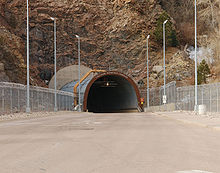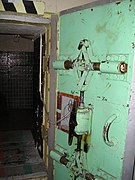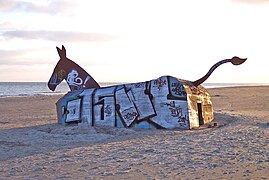
A fallout shelter is an enclosed space specially designated to protect occupants from radioactive debris or fallout resulting from a nuclear explosion. Many such shelters were constructed as civil defense measures during the Cold War.

The Maginot Line, named after the French Minister of War André Maginot, is a line of concrete fortifications, obstacles and weapon installations built by France in the 1930s to deter invasion by Nazi Germany and force them to move around the fortifications.
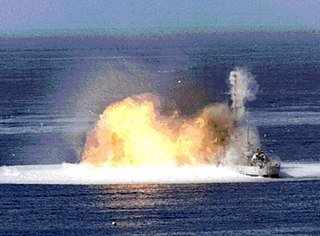
A thermobaric weapon, also called an aerosol bomb, or a vacuum bomb, is a type of explosive munitions that work by dispersing an aerosol cloud of gas, liquid or powdered explosive. Thermobaric weapons are almost 100% fuel and as a result are significantly more energetic than conventional explosives of equal weight. The fuel is often elemental. Many types of thermobaric weapons can be fitted to hand-held launchers, and can also be launched from airplanes.
A neutron bomb, officially defined as a type of enhanced radiation weapon (ERW), is a low-yield thermonuclear weapon designed to maximize lethal neutron radiation in the immediate vicinity of the blast while minimizing the physical power of the blast itself. The neutron release generated by a nuclear fusion reaction is intentionally allowed to escape the weapon, rather than being absorbed by its other components. The neutron burst, which is used as the primary destructive action of the warhead, is able to penetrate enemy armor more effectively than a conventional warhead, thus making it more lethal as a tactical weapon.

A nuclear bunker buster, also known as an earth-penetrating weapon (EPW), is the nuclear equivalent of the conventional bunker buster. The non-nuclear component of the weapon is designed to penetrate soil, rock, or concrete to deliver a nuclear warhead to an underground target. These weapons would be used to destroy hardened, underground military bunkers or other below-ground facilities. An underground explosion releases a larger fraction of its energy into the ground, compared to a surface burst or air burst explosion at or above the surface, and so can destroy an underground target using a lower explosive yield. This in turn could lead to a reduced amount of radioactive fallout. However, it is unlikely that the explosion would be completely contained underground. As a result, significant amounts of rock and soil would be rendered radioactive and lofted as dust or vapor into the atmosphere, generating significant fallout.
A bunker buster is a type of munition that is designed to penetrate hardened targets or targets buried deep underground, such as military bunkers.

A fortification is a military construction designed for the defense of territories in warfare, and is used to establish rule in a region during peacetime. The term is derived from Latin fortis ("strong") and facere.

A bomb shelter is a structure designed to provide protection against the effects of a bomb.
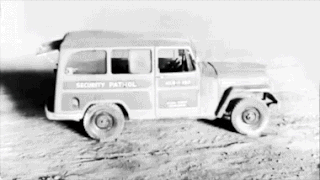
The effects of a nuclear explosion on its immediate vicinity are typically much more destructive and multifaceted than those caused by conventional explosives. In most cases, the energy released from a nuclear weapon detonated within the lower atmosphere can be approximately divided into four basic categories:

Air raid shelters are structures for the protection of non-combatants as well as combatants against enemy attacks from the air. They are similar to bunkers in many regards, although they are not designed to defend against ground attack.

A blockhouse is a small fortification, usually consisting of one or more rooms with loopholes, allowing its defenders to fire in various directions. It is usually an isolated fort in the form of a single building, serving as a defensive strong point against any enemy that does not possess siege equipment or, in modern times, artillery, air force and cruise missiles. A fortification intended to resist these weapons is more likely to qualify as a fortress or a redoubt, or in modern times, be an underground bunker. However, a blockhouse may also refer to a room within a larger fortification, usually a battery or redoubt.

The Diefenbunker, formerly known by its military designation, Canadian Forces Station Carp (CFS Carp), is a large underground four-storey reinforced concrete bunker and nuclear fallout shelter located in the rural area of Carp, Ontario approximately 30 km (19 mi) west of downtown Ottawa. Between 1957 and 1961, during the Cold War the Government of Canada led by then Prime Minister John Diefenbaker authorized the Diefenbunker to be designed and built as the Central Emergency Government Headquarters (CEGHQ Carp) in an attempt to ensure the continuity of government subsequent to a nuclear weapons attack by the Soviet Union. In 1994, CFS Carp was decommissioned and closed.
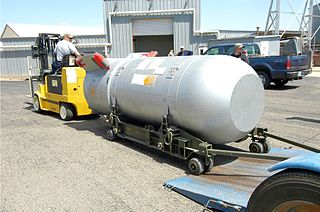
The Mk/B53 was a high-yield bunker buster thermonuclear weapon developed by the United States during the Cold War. Deployed on Strategic Air Command bombers, the B53, with a yield of 9 megatons, was the most powerful weapon in the U.S. nuclear arsenal after the last B41 nuclear bombs were retired in 1976.

An air burst or airburst is the detonation of an explosive device such as an anti-personnel artillery shell or a nuclear weapon in the air instead of on contact with the ground or target. The principal military advantage of an air burst over a ground burst is that the energy from the explosion is distributed more evenly over a wider area; however, the peak energy is lower at ground zero.

A blast shelter is a place where people can go to protect themselves from blasts and explosions, like those from bombs, or in hazardous worksites, such as on oil and gas refineries or petrochemical facilities. It differs from a fallout shelter, in that its main purpose is to protect from shock waves and overpressure instead of from radioactive precipitation, as a fallout shelter does. It is also possible for a shelter to protect from both blasts and fallout.
A blast valve is used to protect a shelter, such as a fallout shelter or bunker, from the effects of sudden outside air pressure changes. A nuclear weapon creates a shock wave, which may produce sudden pressure changes of more than an atmosphere even several kilometres from the detonation point. After the shock wave passes, a sudden negative pressure follows.
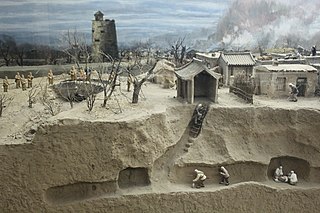
Tunnel warfare involves war being conducted in tunnels and other underground cavities. It often includes the construction of underground facilities in order to attack or defend, and the use of existing natural caves and artificial underground facilities for military purposes. Tunnels can be used to undermine fortifications and slip into enemy territory for a surprise attack, while it can strengthen a defense by creating the possibility of ambush, counterattack and the ability to transfer troops from one portion of the battleground to another unseen and protected. Also, tunnels can serve as shelter from enemy attack.

Dispersal is a military practice of dispersing or spreading out potentially vulnerable military assets, such as soldiers, aircraft, ships, tanks, weapons, vehicles, and similar equipment of an army, navy, or air force. Its primary objective is to minimise any potential effects of collateral damage, from incoming munitions such as artillery, bombs and missiles. Dispersal increases the number of artillery rounds needed to neutralise or destroy a military unit in proportion to the dispersal of the said unit. If a division doubles the area it takes up, it will double the number of artillery rounds needed to do the same damage to it. As more targets are spread out or dispersed, more artillery and / or bombs are required to hit all the individual targets.
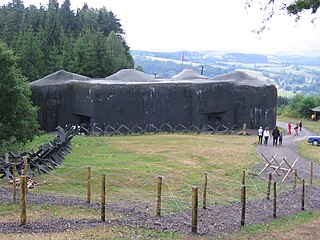
Czechoslovakia built a system of border fortifications as well as some fortified defensive lines inland, from 1935 to 1938 as a defensive countermeasure against the rising threat of Nazi Germany. The objective of the fortifications was to prevent the taking of key areas by an enemy—not only Germany but also Hungary and Poland—by means of a sudden attack before the mobilization of the Czechoslovak Army could be completed, and to enable effective defense until allies—Britain and France, and possibly the Soviet Union—could help.
The Batterie Mirus is located in Saint Peter and Saint Saviour, Guernsey. Originally called Batterie Nina, it comprised four 30.5 cm guns. The battery was constructed from November 1941 and through the first half of 1942, and was the largest battery in the Channel Islands, the guns having a maximum range of 51 km. Although the guns were removed in the early 1950s, the reinforced concrete structures and associated positions remain intact.

